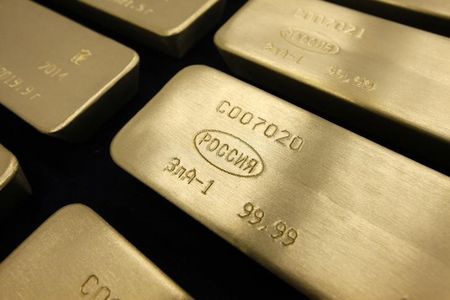Commodities
HSBC raises its average gold price forecasts

Investing.com — HSBC on Tuesday lifted its average gold price forecasts, a move driven by a combination of geopolitical risks, expectations of continued monetary easing, and fiscal imbalances.
The bank points out that gold prices surged to a record high of $2,865 per ounce in late September, fueled by increased safe-haven demand and hedge fund activity. In response to this rally, HSBC adjusted its average price forecasts upward across multiple timeframes.
For 2024, HSBC raised its average forecast to $2,395 per ounce, up from $2,305 previously.
The bank also adjusted its 2025 forecast significantly, raising it from $2,105 to $2,625 per ounce. For 2026, the forecast moved from $2,025 to $2,515 per ounce, while the long-term outlook was lifted to $2,200 per ounce, up from $2,000.
Key factors influencing HSBC’s bullish outlook include persistent geopolitical tensions, particularly in the Middle East, and ongoing economic uncertainty, which has boosted demand for gold as a safe-haven asset.
Growing fiscal deficits are also driving gold demand, HSBC notes. However, as the monetary policy easing cycle continues, further rate cuts “may be progressively less supportive,” the bank’s analysts said in a note.
Meanwhile, exchange-traded funds (ETFs) continue to liquidate their positions, although over-the-counter (OTC) and real money purchases remain robust.
“Long positions on the CME are high but may not rise much further,” the note adds. “Sentiment appears bullish, and while the near-term upward trajectory shows no signs of easing, the rally may be becoming overstretched.”
HSBC also highlights that central banks continue to be major buyers of gold, although purchases have moderated compared to 2022 and 2023 levels. The potential for further U.S. Federal Reserve rate cuts, combined with concerns over fiscal deficits in major economies, has also contributed to gold’s appeal as a hedge against monetary and economic risks.
However, HSBC also noted that the rally might face some headwinds. A firmer U.S. dollar, driven by relative economic strength and possible rate cuts in other economies, could limit gold’s upside. Moreover, while central bank demand remains strong, it is expected to level off unless there is a significant price correction.
Looking ahead, HSBC expects gold to trade within a wide range of $2,350 to $2,950 per ounce through 2025, with year-end targets of $2,725 for 2024 and $2,575 for 2025.
Commodities
Oil prices rise; U.S. crude inventories plunge, Russia-Ukraine truce eyed
Commodities
India’s Reliance to stop buying Venezuelan oil over US tariffs, sources say
Commodities
Oil prices climb on Venezuela supply worries

 Forex3 years ago
Forex3 years agoForex Today: the dollar is gaining strength amid gloomy sentiment at the start of the Fed’s week

 Forex3 years ago
Forex3 years agoUnbiased review of Pocket Option broker

 Forex3 years ago
Forex3 years agoDollar to pound sterling exchange rate today: Pound plummeted to its lowest since 1985

 Forex3 years ago
Forex3 years agoHow is the Australian dollar doing today?

 Cryptocurrency3 years ago
Cryptocurrency3 years agoWhat happened in the crypto market – current events today

 World3 years ago
World3 years agoWhy are modern video games an art form?

 Commodities3 years ago
Commodities3 years agoCopper continues to fall in price on expectations of lower demand in China

 Economy3 years ago
Economy3 years agoCrude oil tankers double in price due to EU anti-Russian sanctions























